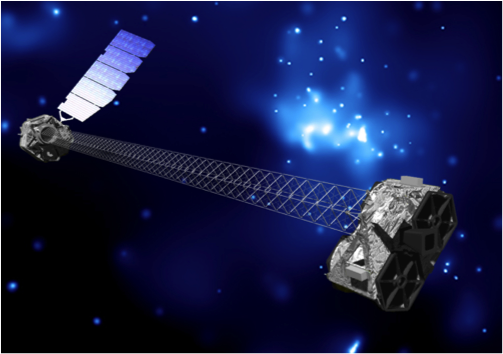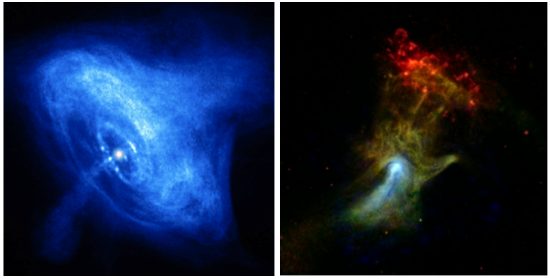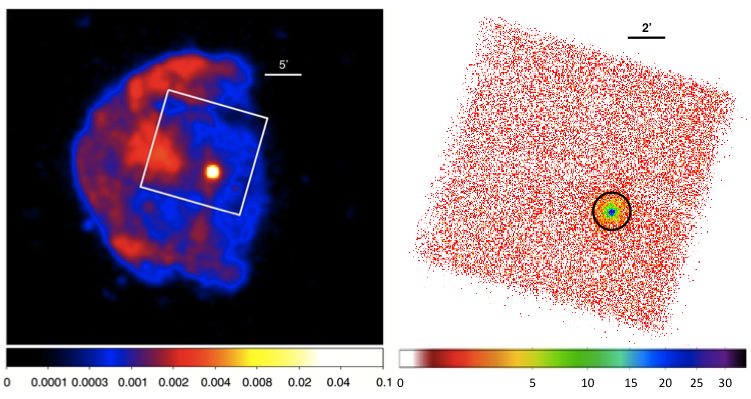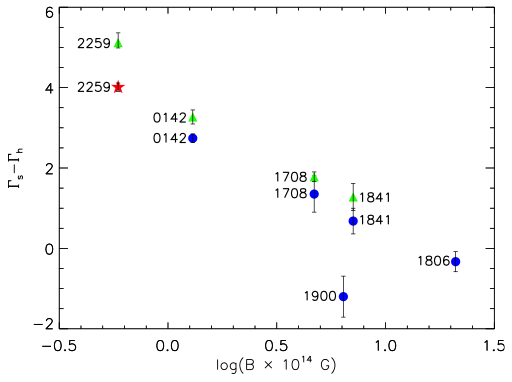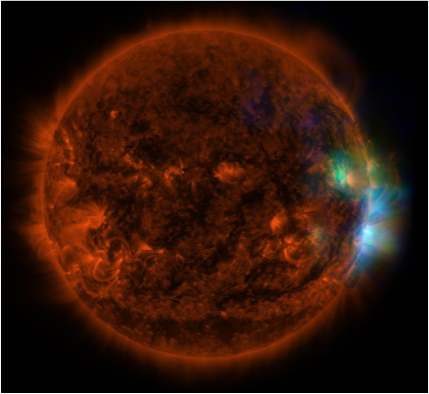Julia Vogel (13-ERD-033)
Abstract
The Nuclear Spectroscopic Telescope Array (NuSTAR, Figure 1), launched in June 2012, helped scientists obtain for the first time a sensitive high-energy x-ray map of the sky with extraordinary resolution. This pioneering telescope has aided in the understanding of how stars explode and neutron stars are born. Lawrence Livermore is a founding member of the NuSTAR project, with key personnel on its optics and science team. We used NuSTAR to observe and analyze the observations of different neutron star classes identified in the last decade that are still poorly understood. These studies not only help to comprehend newly discovered astrophysical phenomena and emission processes for members of the neutron star family, but also expand the utility of such observations for addressing broader questions in astrophysics and other physics disciplines. For example, neutron stars provide an excellent laboratory to study exotic and extreme phenomena, such as the equation of state of the densest matter known, the behavior of matter in extreme magnetic fields, and the effects of general relativity. At the same time, knowing their accurate populations has profound implications for understanding the life cycle of massive stars, star collapse, and overall galactic evolution.
Background and Research Objectives
During the last decades, observational astronomy has expanded from the relatively narrow wavelength band of visible light to the entire electromagnetic spectrum. Covering the band of photon energies from 0.1 keV to several 100 keV, x-ray astronomy belongs to one of the most flourishing of these newly opened spectral ranges. X-ray observations provide insight to phenomena, which occur at the end of stellar life: supernova explosions, neutron stars, and black holes. They can also address questions of cosmological consequences like determining the nature of dark matter. While several missions have studied the sky in soft x rays (below 10 keV), NuSTAR, a National Aeronautics and Space Administration (NASA) mission launched in June 2012, provided the first high-sensitivity observations of the hard x-ray sky up to 80 keV.1 These data have given us the unique opportunity to study a wealth of new astrophysical phenomena.
Even though neutron stars were postulated in 1934 and were first detected in 1967,2,3 our knowledge of these enigmatic end-points of stellar evolution is still limited. Soft x-ray studies have discovered that there are many more members of the neutron-star family than just accretion-powered sources or rotation-powered pulsars (also known as radio pulsars). These new “cousins” identified during the last decade include magnetars and high-magnetic-field pulsars4 and are still a mystery to astrophysicists. Hard x-ray studies not only help understand the newly discovered astrophysical phenomena and emission processes, but they also expand the utility of neutron-star observations for addressing broader questions in physics. For example, neutron stars provide an excellent laboratory to study exotic and extreme physical phenomena because of (1) their high densities of a few 1014 g/cm3 (studies of equation of state of the densest matter known), (2) their extreme magnetic fields of up to 1015 G (behavior of matter in extreme magnetic fields), and (3) effects of general relativity (Nobel Prize, 1993). At the same time, knowing their accurate populations has profound implications for understanding galactic evolution.
The unprecedented sensitivity of NuSTAR arises from its use of solid-state detectors and focusing multilayer optics, the first time such telescopes have been used for hard x-ray astronomy. With its high sensitivity in the x-ray region, NuSTAR is perfectly suited to study the behavior of neutron stars. The hard x-ray regime is especially interesting because certain phenomena begin (or cease) to become the dominant emission mechanism and the physical extent of neutron-star emission is expected to vary with energy. Quantifying these properties requires exquisite knowledge of NuSTAR’s response.
The main objective of this project was the study of magnetars and high-magnetic-field rotation-powered pulsars. Young, isolated neutron stars with an extremely powerful internal magnetic field are known as magnetars. This class of neutron stars is assumed to be powered by the decay of their inner intense magnetic fields (1014–1015 G), which leads to their violent outbursts of x-ray emission. Both the physics of magnetars and their origin are not well understood. While they were long considered to be soft x-ray sources (mainly emitting below 10 keV) with spectra well described by a thermal component plus a hard power-law tail, INTEGRAL (International Gamma-Ray Astrophysics Laboratory) recently detected persistent hard x-ray emission from magnetars.5 While the spectra of different subgroups of magnetars exhibit different hardness below 10 keV, INTEGRAL and subsequently RXTE/HEXTE (Rossi X-Ray Timing Explorer/High-Energy X-Ray Timing Experiment) made the surprising observation that the spectra change dramatically in the harder x-ray regime.6 The sudden upturn in the magnetar spectra between 10 and 20 keV still remains puzzling, as does the change in the relation of relative hardness for different types of magnetars: at higher energies (>10 keV) some magnetar spectra hardly change while those for other magnetar-subtypes become harder. While this behavior is not yet understood, it appears to be crucial in understanding magnetars, because they emit mostly above 10 keV. Recent models addressing the hard x-ray emission from magnetars have been tested with NuSTAR and the mission has constrained the properties of the neutron-star magnetosphere in this extreme high-field environment.
Our secondary objective was using NuSTAR to study pulsar wind nebulae, which result from the interaction of a rotation-powered pulsar with its surroundings. These pulsar wind nebulae, which are only observable from neutron stars with high spin-down luminosities, emit x rays when a relativistic outflow of particles from the neutron star is confined and subsequently shocked by nearby material. The most well-known pulsar wind nebula is the Crab nebula, which is visible, both in the optical and x-ray regimes. A Chandra image of the Crab is shown in Figure 2 (left) along with another famous pulsar wind nebula, PSR B1509-58, nicknamed the “Hand of God” (Figure 2, right; Chandra/NuSTAR data). NuSTAR has provided significant observational constraints and advanced our knowledge of fundamental pulsar physics.
Additional objectives included NuSTAR calibration efforts and the study of solar observations to search for axions (dark matter candidates).
All studies of pulsars with NuSTAR require exquisite knowledge of the behavior for its telescopes in terms of throughput and point-spread function, especially as a function of energy and off-axis position. We are in a unique position to perform this work since, as members of the NuSTAR optics team, we possess the detailed knowledge of both the telescope models and simulation tools that we helped develop. The goal of the calibration was to compare on-orbit calibration data to the physics-based models, to understand the discrepancies between the two (>20%) and ultimately to improve the model to describe the observations.
The second additional objective was the search for solar axions with NuSTAR. Axions are—along with weakly interacting massive particles—favored dark matter candidates able to account for about 25% of the mass in the universe. NuSTAR provided a complimentary approach to conventional axion search experiments. Initial NuSTAR solar observations in search for nanoflares established observational criteria for dedicated axion measurements using the satellite.
Scientific Approach and Accomplishments
To identify new behavior of neutron stars, proving or refuting model predictions and advancing our understanding of these complex objects, we conducted preparatory work including contributions to the NuSTAR calibration as well as the development of algorithms for neutron-star data analysis and tests of these codes on archival data and observational preparations, such as target selection. Once NuSTAR had acquired relevant data, the full analysis process comprised data processing, scientific interpretation, and comparison of results with latest theoretical predictions. Our team analyzed and published data for several high-magnetic-field rotation-powered pulsars—archival data from XMM-Newton/Chandra (X-ray Multi-Mirror Mission) and five NuSTAR-observed neutron stars (four magnetars and one rotation-powered pulsar with a pulsar wind nebula) with additional (simultaneous and/or archival) soft x-ray data. In addition, NuSTAR solar observations were used to validate the application of the instrument for solar axion searches.
We implemented improvements to the modeling of the optics response for the NuSTAR telescopes by refining and upgrading ray-trace simulations for the mission. Specifically, we upgraded the simulated NuSTAR optics response by implementing new optical constants derived from latest metrology measurements and by comparing the results to existing raw calibration data. This reduced the discrepancies between the physics-based models and the on-orbit calibration to 10 to 20%.
X-ray data analysis of high-magnetic-field radio pulsars in archival XMM-Newton and Chandra data verified the performance of the initial neutron-star algorithms and yielded the detection of PSR J1734-3333 in x rays as well as 3σ upper limits on the flux and temperature of two additional objects (PSR B1845-19 and PSR J1001-5939).7 These results support the hypothesis that high-magnetic-field rotation-powered pulsars evolve differently than x-ray-isolated neutron stars, despite their similarities in rotational properties.
In FY13, the first NuSTAR observations of neutron stars were obtained for the magnetar 1E 1841-045. The analysis of these data together with simultaneous (NASA's Swift mission) and archival (XMM/Chandra) soft x-ray observations revealed that the magnetar outflow is consistent with the Beloborodov model (a new model explaining the hard x-ray production in magnetars). As a result, we were able to place new interesting constraints on the geometry of 1E 1841.8
In FY14/15, NuSTAR conducted additional neutron-star observations. A follow-up observation of the galactic center magnetar SGR J1745-2900, previously discovered by NuSTAR, delivered the first-ever timing information on this object.9 Interestingly, we observed an increase of the spin-down rate without the indication of a glitch (a sudden spin-up), hinting at a magnetospheric origin of the event.
Our third observation studied the magnetar 1E 2259+586 (see Figure 3), which had been only marginally detected in hard x rays before NuSTAR.10 Our analysis provided the first-ever detection of a pulse profile at energies >20 keV for this source and constrained the pulsar geometry using the Beloborodov model mentioned above. We also confirmed the connection between spectral turnover (soft minus hard spectral photon index, Γs − Γh) and magnetic field as suggested by Kaspi and Boydstun.11 The red star in Figure 4 indicates our result.
The fourth NuSTAR-observed neutron-star object was the Geminga rotation-powered pulsar with a pulsar wind nebula. These data yielded the first-ever detection of this object in hard x rays (>10 keV), revealing that there is no simple multi-wavelength spectrum able to describe the pulsar over different energy ranges due to a spectral hardening above 5 keV and a spectral flattening between optical and x rays.12
Figure 4. Spectral turnover (Γs − Γh) versus magnetic field including our new result (red star).
Our latest NuSTAR observation (1E 1048.1-5937) yielded a clear detection of this magnetar's persistent emission up to 20 keV. We detected a new feature in the spectrum—that is, a previously unreported small secondary peak in the average pulse profile (7–10 keV), which grows in amplitude with energy and is likely to be transient. In contrast to other magnetars, there is no evidence for the spectral turn-up near 10 keV. The absence of a significant turn-up is consistent with observations from a particularly active subset of magnetars having high spin-inferred magnetic fields.
In addition, to our NuSTAR neutron-star program, we participated in first solar observations. While the primary goal of these solar data is the search for nanoflares able to address the coronal heating problem, these observations can also be used to lay the foundation for solar axion searches. Axions would be produced in the solar core and could convert into x rays in the magnetic fields of the photosphere resulting in an excess of x rays in the center of the solar disk. By definition (axions were initially postulated to solve a problem in quantum chromodynamics) these particles could account for part or all of the dark matter in the universe. We used the first NuSTAR solar data to determine the best conditions for a dedicated, future axion observation and work towards first upper limits on the axion-to-photon coupling constant for hadronic axion-models.
Figure 5. Image of the Sun combining hard x-ray data (NuSTAR) in blue, soft x-rays observations (Hinode) in green, and extreme ultraviolet data (Solar Dynamic Observatory, SDO) in yellow and red (NASA/JPL-Caltech/GSFC/JAXA).
Impact on Mission
Participation in space science is a crucial element in the Laboratory’s cyber and space security and intelligence strategic mission thrust. LLNL’s ability to provide next-generation capabilities for security of space requires a trained workforce with demonstrated excellence in conceiving, fabricating, and performing science with advanced instrumentation. Our analysis of NuSTAR observations of neutron stars strengthened the Laboratory’s preeminence in x-ray astronomy and further strengthened LLNL’s expertise in high-energy astrophysics as well as Livermore's core competency in high-energy-density physics and nuclear, chemical, and isotopic science and technology.
Conclusion
Discoveries during the last 20 years have revealed new manifestations of neutron stars and shown that our understanding of these important astrophysical objects is still limited. X-ray observations are crucial for unraveling the complex nature of neutron stars, and with NuSTAR, we were able to conduct sensitive observations in the hard x-ray band for the first time. Our work in developing and characterizing NuSTAR’s focusing optics and our previous work on neutron stars provided LLNL with a unique opportunity to make important contributions to this cutting-edge research field. Additional data from NuSTAR and the soon-to-be-launched JAXA (Japan Aerospace Exploration Agency) Astro-H mission will further our understanding of neutron stars. Livermore is well positioned to analyze these data as well as lead the development of future x-ray optics for a “super” NuSTAR-type observatory, the X-ray Surveyor, as well as for axion searches and for diagnostics used in NNSA projects.
References
- Harrison, F. A., 2013, “The Nuclear Spectroscopic Telescope Array (NuSTAR) high energy x-ray mission.” Astrophys. J. 770(2), 103. LLNL-JRNL-642088.
- Baade, W., and F. Zwicky, "Remarks on super-novae and cosmic rays." Phys. Rev. 46(1), 76 (1934).
- Hewish, A., et al., “Observation of a rapidly pulsating radio source.” Nature, 217, 709 (1968).
- Kaspi, V. M., “Grand unification of neutron stars.” Proc. Natl. Acad. Sci. Unit. States. Am. 107, 7147 (2010).
- Winkler, C., et al., “The INTEGRAL mission," Astron. Astrophys. 411, L1 (2003).
- Bradt, H. V., R. E. Rothschild, and J. H. Swank, “X-ray timing exploring mission.” Astron. Astrophys. Suppl. 97(1), 355 (1993).
- Olausen, S. A., et al., “X-ray observations of high-B radio pulsars.” Astrophys. J. 764(1), 1 (2013). LLNL-JRNL-644873.
- An, H., et al., “NuSTAR observations of magnetar 1E 1841−045.” Astrophys. J. 779(2), 163 (2013). LLNL-JRNL-642086.
- Kaspi, V., et al., “Timing and Flux evolution of the galactic center magnetar SGR J1745-2900.” Astrophys. J. 786(2), 84 (2014). LLNL-JRNL-656058.
- Vogel, J. K., et al., “NuSTAR observations of the magnetar 1E 2259+586.” Astrophys. J. 789(1), 75 (2014). LLNL-JRNL-650575.
- Kaspi, V. M., and K. Boydstun, “On the x-ray spectra of anomalous x-ray pulsars and soft gamma repeaters.” Astrophys. J. Lett. 710(2), L115 (2010).
- Mori, K., et al., “A broadband x-ray study of the Geminga pulsar with NuSTAR and XMM-Newton.” Astrophys. J. 793(2), 88 (2014). LLNL-JRNL-662642.
Publications and Presentations
- An, H., et al., “NuSTAR observations of magnetar 1E 1841-045.” Astrophys. J. 779(2), 163 (2013). LLNL-JRNL-642086.
- An, H., et al., “NuSTAR results and future plans for magnetar and rotation-powered pulsar observations.” Astron. Nachr. 335(3), 280 (2014). LLNL-CONF-644819.
- Harrison, F. A., “The Nuclear Spectroscopic Telescope Array (NuSTAR) high energy x-ray mission.” Astrophys. J. 770(2), 103 (2013). LLNL-JRNL-642088.
- Kaspi, V., et al., “Timing and flux evolution of the galactic center magnetar SGR J1745-2900.” Astrophys. J. 786(2), 84 (2014). LLNL-JRNL-656058.
- Mori, K., et al., “A broadband x-ray study of the Geminga pulsar with NuSTAR and XMM-Newton.” Astrophys. J. 793(2), 88 (2014). LLNL-JRNL-662642.
- Olausen, S. A., et al., “X-ray observations of high-B radio pulsars.” Astrophys. J. 764(1), 1 (2013). LLNL-JRNL-644873.
- Vogel, J. K., et al., “NuSTAR observations of the magnetar 1E 2259+586.” Astrophys. J. 789(1), 75 (2014). LLNL-JRNL-650575.


